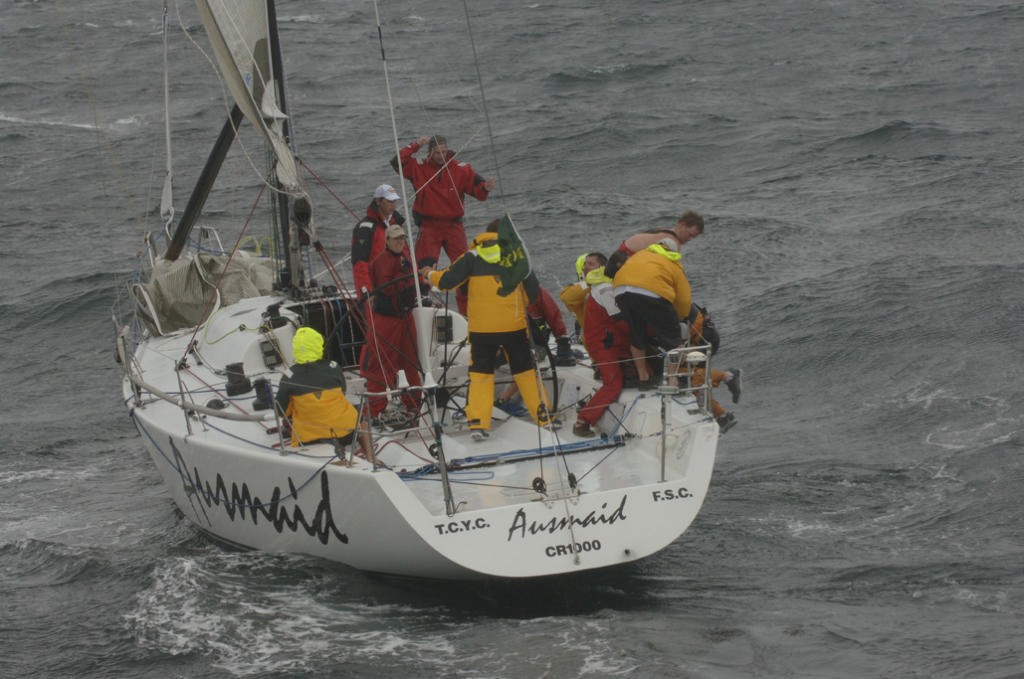Why do we Drown? How to increase your chances of survival
by Basil Orr on 10 Dec 2009

Ausmaid’s crew recovering bowman Aaron Linham after he was dragged overboard on Day 2 of the Rolex Trophy Rating Series off Sydney Heads. Are you prepared? Peter Andrews
http://www.outimage.net
Professor Michael Tipton from University of Portsmouth, UK spoke to 500 yachtsmen and marine emergency crews at RNZYS on 24 November 2009, with an entertaining address well supported with photos, videos and charts.
He has studied survival at the well equipped university laboratories for more than 25 years, using fit soldiers from the Royal Marines and students as subjects.
Every year on average more than 100 New Zealanders drown, either in boating accidents or other incidents on our rivers, lakes and seas.
Some people drown after entering the water intentionally (for example when swimming or diving), but most drown after accidental immersion. However, almost all drownings are preventable.
Understanding how your body will respond when you suddenly find yourself in a river, lake or the sea will significantly improve your chances of survival. Wearing a lifejacket, personal flotation device or some other buoyancy aid will also greatly improve your chances if the unexpected happens.
All of us have experienced the effects of entering the water – and the colder the water, the more noticeable the involuntary response. But we can just as easily drown in water of any temperature. The key difference is how we enter the water – intentionally or unexpectedly.
COLD SHOCK
When our skin suddenly cools, two main responses occur – surface blood vessels constrict and our heart rate increases, often doubling its normal rate. Our blood pressure rises, and together these responses create the risk of a heart attack.
If our heart keeps going, we also have to survive the respiratory response, which starts with an involuntary gasp and hyperventilation. Breathing becomes difficult. This can lead to drowning within moments of entering the water. These initial responses are commonly described as 'cold shock'.
There is little you can do to guard against cold shock, but knowing what is happening may well reduce your inclination to panic (which can impair breathing and hasten drowning) and increase your chances of survival. If you are near water and there is even a remote chance you may fall in, then wearing a buoyancy aid or lifejacket will hugely increase your chance of surviving.
MUSCLE STRENGTH LOSS
Having survived an initial immersion in water, many drown within a short time. Blood retreats from our extremities as our body seeks to protect the vital organs in the chest from cooling, and our limbs cool very rapidly. Within minutes, the lowering temperature in our muscles reduces their strength – though this occurs more slowly in warmer water.
The chemical and electrical reactions that control our muscles slow down, and our muscles stop working – we can do nothing at this time to help ourselves. People can not even hold up their head or avoid inhaling water. We often hear that the victim 'was a strong swimmer'. Again, our greatest hope of survival is provided by a lifejacket.
Often we hear reports that a drowned person was affected by hypothermia. The term is widely used when a person is very cold, but strictly speaking it refers to the cooling of the inner vital organs. Recent research shows that even a thin person can not lose heat quickly enough to die from hypothermia within 30 minutes in freezing water. The cause of death when immersed in water is drowning, usually caused by cold shock and the ensuing loss of muscle strength.
LIFEJACKETS SAVE LIVES
Wearing a buoyancy aid is the most practical measure available to help prevent drowning – other than not entering the water in the first place. Most people who drown are close to shore or help – sometimes within 2 metres. Of course, those in a boating mishap may well only survive if they also have the means to communicate that they need help.
Lifejackets and buoyancy aids are now very comfortable to wear, with inflatables becoming increasingly popular. Lifejackets are effective, arguably more so at preventing loss of life than a seatbelt. Logic tells us that wearing a buoyancy aid on or near the water should be just as automatic as putting on a seatbelt – except when we intend to go for a swim, or a surf. Being prepared is important, because boating accidents and falls into the water happen frequently and without warning, just as car accidents do.
For more information, get Michael's book: Essentials of Sea Survival by Frank Golden & Michael Tipton
http://www.fishpond.co.nz/Books/Sports_Recreation/Boating/9780736002158
or visit www.maritimenz.govt.nz and search for 'lifejackets' or 'cold water'.
If you want to link to this article then please use this URL: www.sail-world.com/64277